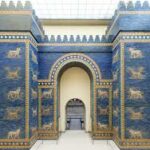Berlin Museum Guide: Discover the City’s Cultural Treasures
Welcome to the ultimate Berlin Museum Guide – your curated gateway to the city’s most fascinating museums and cultural landmarks. Whether you’re passionate about art, history, or innovation, Berlin offers an unparalleled variety of experiences that inspire and educate.

Top Museums in Berlin
- Alte Nationalgalerie: Paintings and sculptures from the 19th century, including works by Caspar David Friedrich and Adolph Menzel.
- Pergamon Museum: Archaeological wonders like the Pergamon Altar and the Ishtar Gate.
- Jewish Museum Berlin: A deeply moving journey through Jewish history, culture, and identity.
- German Museum of Technology: Aviation, maritime history, and interactive exhibits for all ages.
- DDR Museum: Life in East Germany – hands-on, immersive, and unforgettable.
- Topography of Terror: A documentation center on the Nazi regime, located at the former Gestapo headquarters.
What Makes Berlin’s Museums Truly Unique
Berlin’s museums aren’t just about dusty paintings or ancient statues – they reflect the city’s contradictions, its scars, and its constant transformation. Here, museums are not passive spaces. They challenge, engage, and sometimes even provoke.
- History in Motion: Berlin’s turbulent 20th century is not just documented – it’s palpable. The Topography of Terror is located on the site of the former Gestapo HQ. The DDR Museum lets you sit in a Trabi or peek into East German kitchens.
- Spaces with Soul: Many museums are housed in buildings that are stories themselves – like the Jewish Museum, whose architecture by Daniel Libeskind is as much part of the experience as the exhibition.
- Immersive & Playful: From optical illusions at the Illuseum to full-size planes at the German Technology Museum – Berlin’s museums go far beyond glass cabinets.
- Culture in Dialogue: Many institutions focus on present-day questions – migration, identity, urban change – and involve the community in shaping exhibitions.
- Ever-Evolving: New concepts like the Futurium explore tomorrow’s ethics and technologies. Berlin’s museums are not static – they grow with the city.
In short: Berlin’s museums reflect the city itself – bold, layered, and never boring.
Did you know?
Berlin has more museums than rainy days: over 170 museums across the city compared to an average of 106 rainy days per year.
From ancient Babylonian gates to immersive GDR apartments, the city’s collections are as eclectic as its neighborhoods.
Hidden Museums in Berlin You’ve Probably Never Heard Of
Beyond the big names, Berlin is home to a wealth of small and surprising museums – from abandoned bunkers to typography collections. These hidden gems reveal lesser-known layers of the city’s soul.
- The Gasometer Museum – Housed in a former gas holder in Schöneberg, this industrial relic offers a dramatic panorama and insight into Berlin’s energy history.
- The Museum of Letters (Buchstabenmuseum) – A paradise for typography fans. Neon signs, storefront letters, and urban visual culture come alive in this unique collection.
- AlliiertenMuseum (Allied Museum) – Located in a former US cinema, it explores Berlin during the Cold War through original planes, spy equipment, and more.
- The Hemp Museum (Hanf Museum) – This niche museum in Mitte dives into the history, culture, and legal debates surrounding cannabis in Germany and worldwide.
- Sammlung Boros – A private art collection inside a WWII bunker near Friedrichstraße. Visits are only via guided tour – booking essential.
- Beate Uhse Erotikmuseum (defunct) – Though now closed, its legacy lives on as a symbol of Berlin’s fearless openness to taboo topics. Worth referencing in cultural retrospectives.
- Museum der Dinge – Run by the Werkbund Archive, this curious museum showcases everyday objects and industrial design that shaped 20th-century life.
- Silent Green Kulturquartier – Not a traditional museum, but an artistic space in a converted crematorium. Temporary installations, films, and sound-based art.
These museums may not have long lines or gift shops – but they offer rare, raw insights into Berlin’s spirit. The kind of places locals whisper about and explorers remember.
Berlin Museums by Theme: Explore What You Love
Whether you’re an art lover, tech enthusiast, or history buff – Berlin’s museum scene has a theme for everyone. Here’s how to find what fits your interests best.
🎨 Art & Design
- Alte Nationalgalerie – 19th-century classics from Caspar David Friedrich to French Impressionism.
- Hamburger Bahnhof – Berlin’s temple of contemporary art in a former train station.
- Bröhan-Museum – Art Nouveau, Art Deco & Bauhaus applied arts.
🧠 History & Politics
- DDR Museum – Hands-on insights into life in East Germany.
- Topography of Terror – Nazi history in the heart of Berlin.
- German Historical Museum – Germany from the Middle Ages to modern times.
🔬 Science & Technology
- Deutsches Technikmuseum – Steam engines, aircraft, computing and more.
- Science Center Spectrum – Over 150 hands-on experiments for curious minds.
- Medizinhistorisches Museum – Medical history from anatomical wax models to surgical tools.
👨👩👧👦 Family & Kids
- Natural History Museum – Dinosaurs, minerals, and the famous T-Rex Tristan.
- Labyrinth Kindermuseum – Interactive experiences designed especially for children.
- Computerspielemuseum – From Pong to PlayStation – a playable museum for all ages.
🌍 Global Cultures
- Ethnological Museum – One of the world’s largest collections of non-European cultures.
- Jewish Museum Berlin – Powerful, immersive storytelling and architecture.
- Museum of Islamic Art – Located inside the Pergamon complex, with treasures from across the Islamic world.
Berlin's Top 10 Museums – Interactive Map
Explore Berlin’s must-see museums on an interactive map. From ancient artifacts to digital art, these ten spots are essential stops for culture lovers.
FAQs About Berlin's Museums
Which Berlin museum has the most interactive exhibitions?
The DDR Museum offers a fully immersive experience of everyday life in East Germany. Visitors can open drawers, sit in a recreated living room, and even simulate driving a Trabant car.
Are there museums in Berlin that focus on contemporary culture or subcultures?
Yes, the Urban Nation Museum for Contemporary Urban Art is dedicated to street art and urban culture, showcasing works from graffiti artists around the world.
What is the most underrated museum in Berlin?
The Museum of Things (Museum der Dinge) in Kreuzberg explores everyday design and material culture in Germany, offering a unique look at objects most people overlook.
Are there museums with night openings or special evening events?
Several museums, such as the Hamburger Bahnhof and the Jewish Museum, host special events like "Long Night of Museums" and evening exhibitions with music, food, or talks.
Which museums are best suited for families with children?
The Natural History Museum (with its T. rex skeleton) and the German Museum of Technology are particularly popular with families thanks to hands-on exhibits and kid-friendly programs.
Plan Your Museum Day
A perfect museum day in Berlin needs a little planning: opening hours vary, queues can be long, and some collections are simply too large to cover spontaneously. Here’s how to make the most of your time.
- 🎫 Check Ticket Options in Advance: Many popular museums require timed-entry tickets. Booking online helps avoid queues and ensures availability — especially for limited exhibitions.
- 🗺️ Map Out a Logical Route: Combine museums that are close to each other. For example, visit the German Historical Museum and the Humboldt Forum on the same day.
- ⏰ Use the “90-Minute Rule”: Most visitors reach their limit after 90 minutes. Plan a break or café stop before heading into the next museum.
- 🧠 Choose a Theme: Instead of quantity, go for depth. Explore only Jewish history, contemporary art, or Cold War culture — it makes the experience more coherent and memorable.
- 👟 Dress for Comfort: Berlin museums often involve stairs, long halls, or interactive zones. Comfortable shoes and light layers are recommended.
- 🕓 Mind the Museum Rhythm: Some museums open later or have extended evening hours on Thursdays — perfect for night owls or busy mornings.
Insider Tips for Berlin’s Museum Scene
Beyond the usual advice, here are some real insider tips to help you explore Berlin’s museums like a local — more authentic, less crowded, and with a deeper experience.
- 🕯️ Hidden History in a Pharmacy Cellar: Beneath the Berlin Medical History Museum lies a preserved 19th-century apothecary cellar — rarely visited, but unforgettable.
- 🎟️ Free Entry on Thursdays (Sometimes): Smaller museums like the Literature Museum at Humboldt University often waive entrance fees after 5 p.m. on select weekdays.
- 📻 Take a Pocket Radio: Some museums (like the GDR Museum) broadcast background sounds on FM frequencies — a simple radio turns your visit into a time capsule.
- 📚 Combine Archives with Cafés: The Akademie der Künste on Pariser Platz has a peaceful library with art books — perfect for a quiet hour before sunset.
- 🌙 Visit Museums at Night: During “Lange Nacht der Museen” (Long Night of Museums), you get after-hours access, music, and open rooftops — an annual experience you shouldn’t miss.
- 👁️ Seek Out the Smallest Exhibit: At the Natural History Museum, there’s a hidden microscope room where Berlin scientists first studied bacteria in WWI — it’s tucked behind the fossil hall.








